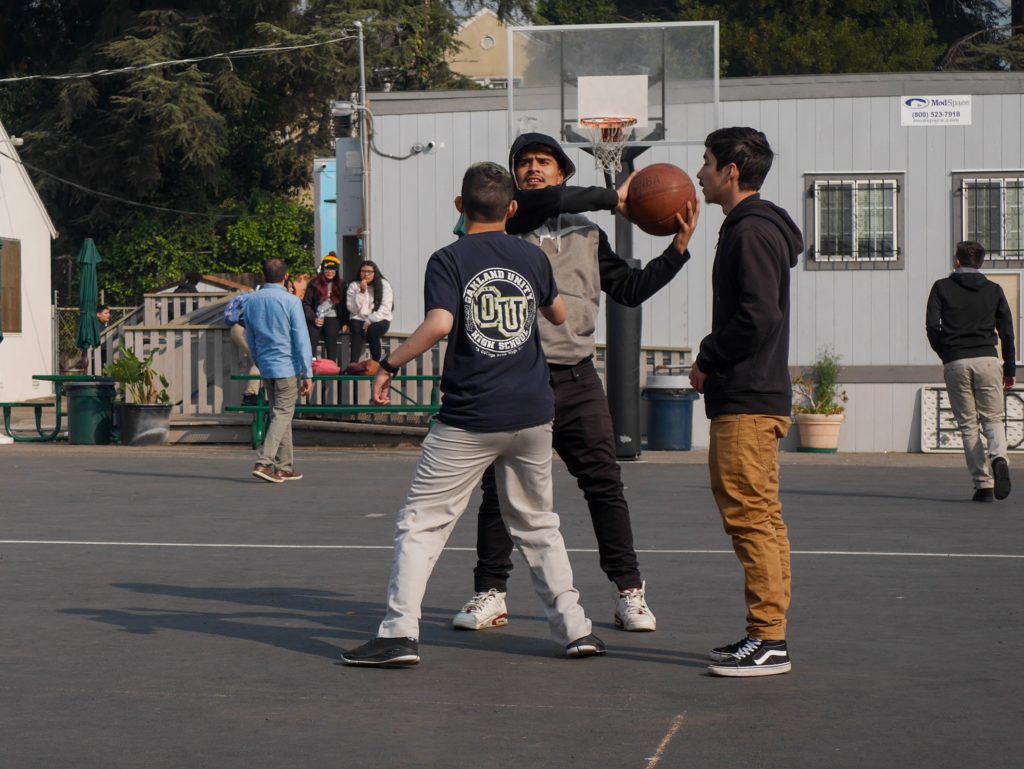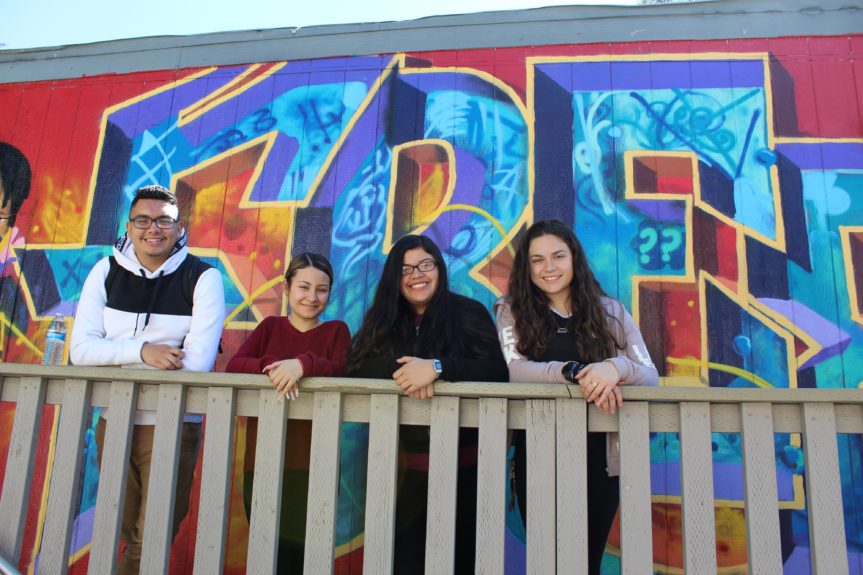Guest post from Families in Action for For Quality Education
Teachers raise the bar and students rise to meet the challenge at Oakland Unity High School, one of the top performing high schools in the city.
The Oakland Unity High School campus doesn’t look a thing like one might imagine a traditional high school. No big buildings with engraved inspirational quotes, no field, no bleachers, no auditorium. The campus is located in the middle of the block next to a church and looks like a Spanish mission. If you’re passing by, you’ll probably miss it.
Entering through the front gate, the campus opens up into a courtyard enclosed by an old church school building, where many Unity classes are held, and portable classroom units. There are a few scattered tables and two portable basketball hoops. During a break, the quiet courtyard transforms with noise and movement as it swells with students.
“You know, I’ve had my share of (district) public schools but this is my first charter school,” says Jessica, a Unity High 11th grade student, sitting on a courtyard table with classmate Oscar during a morning passing period. “At first when I transitioned here, I was like, ‘Wow, this is really small. It’s way different.’”
“But honestly, I love how it’s a small community,” she continues. “It’s crowded but we all enjoy seeing each other and we all get along.”
Oakland Unity High School is far from the average Oakland high school: it’s one of the top performing public high schools in the city. Where taking the hardest classes with the toughest teachers is seen as a badge of honor. Inside the small campus, a tight-knit group of educators and students are thriving on high expectations and a school philosophy and culture that focuses on advancement through individual determination.
“We really try to have our students believe that anybody who walks through the door to our school has the potential to be successful,” says Will Nee, now in his 10th year as Unity High’s principal, “and has the potential to make progress towards their dreams and towards a successful future, becoming someone who’s going to move their community forward.
“We believe that working hard consistently, day after day, year after year, people can make dramatic changes in their life.”

Unity High showed impressive growth on the most recent SBAC test, posting huge gains in math (+10.47%) and in English Language Arts (+9.26%). Half of Unity High students, who are predominantly Latino and Black, are proficient in math; 7 out of 10 are proficient in ELA. For comparison, across Oakland, less than 3 out of 10 Latino and Black students are proficient in math and 2 out of 10 Latino and Black students are proficient in ELA.
Jessica and Oscar have just gotten out of teacher Matt Brennan’s English class the previous period. The students are working on rhetorical essays, building towards both the SAT and the AP exam (students can opt in to the AP track). “(In the Spring) they should be able to write these in an hour,” Brennan says, “whereas here, I’m giving them the whole week.”
Brennan’s class is challenging and he’s tough — constantly asking students why they came up with that answer. He even calls on a guest to answer a question during class (sadly, the guest gets the question wrong). Typically, though, he isn’t calling on students so much as having a discussion with the class.
During a class discussion, Oscar answered a question about whether a word ending in an “s” was plural or singular. Even though he answered the question correctly, Brennan kept prodding, playing devil’s advocate and asking Oscar how he came up with his answer. “He’ll ask you a question and basically it’s like he’s almost trying to get you to be wrong,” Oscar says. “Some people will be like, ‘Oh, if he’s questioning it, I must be wrong.’ Instead, he makes you critically think: why is this the answer?”
“He tries to get you out of your comfort zone and actually think and figure it out,” Jessica adds. “It’s sort of uncomfortable but it really does help. I see the progress, and I can see that in that class I struggle but it’s a good kind of struggle where I get through it, and it actually helps us learn.”
Brennan says Unity High teachers discuss the way students “think about and approach challenging work, and their academic personality and what that means.”
“We’ve been building momentum on that and by focusing on the basics, on their mindset, to address a lot of the academic challenges that students have been facing,” he says.

The growth that the Unity High students displayed on the SBAC test has played out on campus as well, Nee says. “The class of 2020, there are some amazing people, but in 9th grade they were not the greatest test takers,” Nee says. “For them to do better than the class of 2019 and do so well in the city as a whole speaks to their growth over their time at the school. There was a lot of hard work on their part.”
For ELA, that work begins in 9th grade and it begins underground, literally. Freshman English teacher AJ Wood’s class is held in a windowless basement below Brennan’s class. “I don’t even notice,” Wood says, “I guess because the walls are yellow, we have all these books, and I keep the Christmas lights on. The kids don’t seem to mind it either.” This is also where alignment with the upper grades starts — for the essay her class is working on, Wood uses a rubric that shows thesis statement expectations for students year-by-year throughout high school.
“I show them the 9th grade and the 10th grade level, and I tell them I’ll give them extra credit if they go for the 10th grade,” Wood says. “They can see what’s expected of them for each grade level. They can think, ‘This is what I’m expected to do next year. I can push for that if I want to challenge myself and earn extra points, too.”
This is where the growth starts, and it’s a slower process. Students arrive at various levels; some are learning English. There’s a lot of meeting students where they are. “I’m introducing a lot to them,” Wood says. “A lot of them have never written a full essay before.”
Wood is in her fourth year teaching at Unity and she’s especially proud of the students’ performance on the SBAC because they were a part of her first class at the school. Now she teaches some of their younger siblings. “It’s so exciting to be a part of something and actually see a positive result,” Wood says. “The worst part is when you feel like you’re working so hard but don’t see the fruit of your labor. Knowing that we are actually increasing their reading and writing was very exciting.”

Nee says his goal is for teachers like Wood and Brennan to “come in and be their best self as a teacher every day.”
“There’s a sweet spot where you’re crushing it every day but not getting burned out,” Nee says. “We try to model hard work for our students, and also model self care, and being there for the long haul.”
By the time Unity High students are 11th graders, like Oscar and Jessica, they relish the challenges they’re offered.
“Something different about the teachers here is they help us fix ourselves,” Jessica says. “How to grow as a person and solve difficult problems. Our mentality, they understand the way we think as students. Whenever we struggle, when we see a problem that’s so difficult, we shut down and pretend we’re working and wait for the answer.
“No. He wants us to fix ourselves, get us out of that mentality. And grow.”

